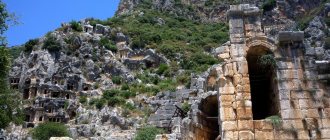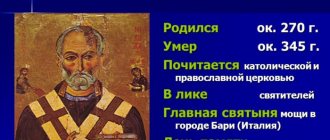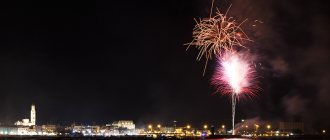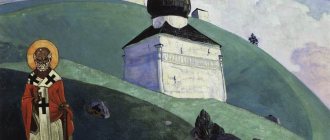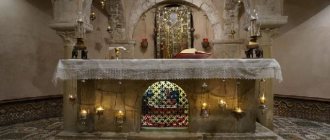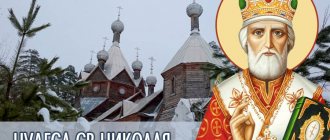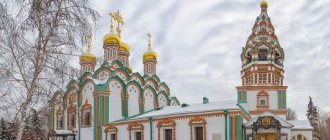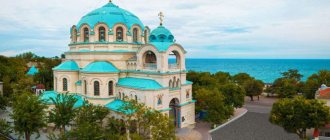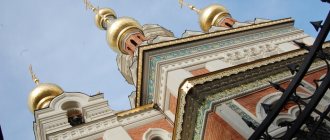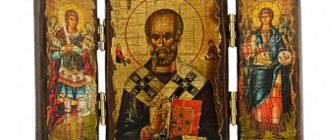The main goal of our trip to Anatolia was to visit the Church of St. Nicholas the Wonderworker in Demre, Turkey. This place is one of the most significant Christian shrines in the East. It is also the birthplace of St. Nicholas the Wonderworker of Myra in Lycia, who is revered primarily by Russian and Greek Orthodox Christians.
Not everyone knows this Christian saint. He is more familiar as a storyteller and wizard who brings gifts to children around the world on Christmas Eve. This amazing man is known by many names: Father Frost, Santa Claus, Nikolaus, Joulupukki, Babbo Natale, Noel Baba. But in this article we will talk about a real person who lived in the 4th century and served in the very place where the temple in Demre, named after him, is now being restored.
And in this video I really wanted to convey the spirit of this place. I really hope that you can feel it too.
Why is the area around Derme so unusual?
The small and cozy seaside town of Demre is today called the “capital of tomatoes” - here these vegetables grow especially juicy and sweet, as if saturated with the energy of the hot southern sun and gentle sea. The coastline is literally a couple of kilometers from here along the D400 coastal highway. You can read more about our one-day independent trip from Belek to Demre here, and the coordinates and detailed route to the attraction are described at the end of this article.
In addition to numerous tomato greenhouses, there are photographs of a wide variety of tomatoes on billboards along the roads.
But the history of this place is much more exciting than it might seem at first glance. Of course, if you manage not to notice the mass of souvenirs on the theme of St. Nicholas, which are sold here at every turn.
The ancient city of Demre was built on the site of Myra, famous since time immemorial, which was located in the Lycian region.
The place where the Church of St. Nicholas, people from ancient times considered it extraordinary - in pre-Christian times, the Temple of Artemis was located here. And the priests here praised their gods.
At the turn of our era, the Apostle Paul visited Myra on his way to Rome and addressed the inhabitants of Myra with a sermon. This is the background to the emergence of the Christian community in the city.
Today, tombs built into rocky slopes and an ancient amphitheater remind us of those times.
Later, Mira became an important Christian center, but the enduring glory of the city is precisely the image of St. Nicholas the Wonderworker, whose difficult earthly path ran through these places. To visit where a great saint once lived and preached is an incomparable feeling.
The name of St. Nicholas the Wonderworker is well known to everyone, regardless of religion. He found special reverence in our country. But not everyone knows the real facts about this extraordinary holy man.
List of travel agencies
The excursion “Demre – Myra – Kekova” can be purchased from representatives of the following travel agencies:
- Natalie Tours – $65;
- Pegas Touristik – $60;
- Anex Tour – $60;
- Tez Tour – $55;
- Coral Travel – $55.
Excursions can also be purchased at local travel agencies. Such a trip will cost you $35–45. However, a low price may negatively affect the quality of the service, so find out the travel conditions in detail.
Saint Nicholas - life and legend
From the time of the Roman Empire, enough historical sources have been preserved to allow us to say with confidence that in the year 300, the post of bishop of the city of Myra was taken by a clergyman named Nicholas. At that time he was 55 years old.
Here is another confirmed historical fact: the future saint was born in a city called Patara, two days’ journey from the city of Myra in Lycia. By the way, he was of noble origin and could have led the calm and prosperous life of an aristocrat, devoid of worries about his daily bread. Some sources report that Nicholas's father was a navigator and shipowner - this is one of the explanations why he is considered the patron saint of sailors.
This does not happen often, but the future archbishop of Myra of Lycia was completely indifferent to material wealth, having been generously gifted with them since childhood. Most people were pragmatic then, as they are today, but Nikolai, in his youth, chose for himself the path of serving God and helping people in need.
Every resident of Demre can tell you about what happened then, in the first half of the 4th century: Nicholas the Wonderworker received this nickname for his ability to heal people, even those on the verge of death, and also protect them from the violence of the elements.
Here are just a few famous stories.
The first miracle . Once, during a storm, Bishop Nicholas brought back to life a sailor who had fallen from the mast. With his deep faith and the power of prayer, the saint revived the unfortunate man, although, having fallen from such a height, he should have fallen to death.
Eyewitnesses were shocked, and the glory of St. Nicholas the Wonderworker began to quickly spread in the surrounding lands and throughout all Christian countries. The Saint of Myra of Lycia became a conduit of divine help for sailors and all those who suffer disaster due to the fault of the violent waters of the sea.
The second miracle is also connected with the water element: Nicholas was making a pilgrimage to the Holy Land, and the ship on which he was sailing was overtaken by a severe storm on the open sea. The power of prayer offered to the saint managed to tame the elements and save the ship, which then safely reached the shore.
The third miracle involves unexpected wealth and marriage. The father's wealthy father had 3 beautiful daughters. But one day he went completely broke and became a beggar. There was not enough money even for food, not to mention the necessary dowry to marry off their daughters. Then, in desperation, he decided to sell the innocence of his daughters in order to at least slightly improve his financial situation.
Saint Nicholas became aware of these criminal thoughts, and he decided to save the family from material poverty so that they would not perish from spiritual poverty. Therefore, secretly at night he threw a bag of gold coins through the window of the house. The unfortunate father gratefully accepted such a gift, after which he was able to successfully marry off his daughters.
Archbishop Nicholas died in 343, 2 years short of reaching 100 years of age. The saint was buried in the church where he was the main Christian shepherd of all Lycia for almost half a century.
After his death, he was canonized, and his healing relics began to be revered by believers. But centuries later, an event occurred that has no clear assessment. There are two opposing interpretations.
Around the 11th century, when a strange phenomenon – the “hunt for relics” – was in full swing in Europe, representatives of the Christian community of the Italian town of Bari stole the remains of St. Nicholas, took them out of Demre and declared them their shrine.
There is another version of this event. In 1087, Saint Nicholas appeared to one pious priest of the Italian city of Bari in a dream and said that he did not want his remains to remain in the desert. It was after this that an expedition was organized to Myra, from where the relics of the saint were delivered with honors to Bari, where they remain to this day.
LiveInternetLiveInternet
It turned out to be very long, but what I saw, heard and read about the Church of St. Nicholas was so inconsistent that I wanted to figure it out.
My great-grandmother and grandmother on my mother’s side were deeply religious and strictly observed church canons and rituals. Therefore, when I visited them in childhood and adolescence, I found myself in the information field of Orthodoxy, which, undoubtedly, was reflected in my relationship to religion. For example, if I suddenly find myself in a church, then the first thing I do is certainly look for the icon of St. Nicholas the Wonderworker to light a candle next to it. Why is that? I don’t know: maybe because he was the most revered saint in the house, or maybe because I liked his icon in the home iconostasis the most at that time. Here she is.
Saint Nicholas the Pleasant of Myra
Now this icon is kept in my possession.
Naturally, my attitude towards Nicholas the Wonderworker is purely subconscious: I didn’t bother to find out either his biography or his deeds, and I perceived the definition “Mirlician”, sometimes mentioned along with his name, as a set of letters, apparently having some meaning in the church hierarchy.
Therefore, when going on an excursion tour to Turkey in ancient Lycia, I in no way connected the program visit to the Church of St. Nicholas in Demre with the image of St. Nicholas the Wonderworker. And he even seriously considered the possibility of escaping from the group while visiting the church to see the ancient rock tombs of the Lycian kings. Fortunately, they were only a couple of kilometers from the temple.
But already on the spot, having soberly assessed the situation, I decided not to tear myself away from the team.
And at some point, the information puzzles came together into a picture, and I suddenly realized that the church included in the tour program is directly related to that same St. Nicholas the Wonderworker and stands on the site of his burial.
I’ll say right away: visiting the temple gave me interesting feelings, both emotional and physical. I have been looking for a definition for them for a long time. Perhaps this feeling can most accurately be described as blissful. It’s difficult to say what became its source: either the aura of a place of worship (there was a temple of Artemis here even before the Christian church),
or the coolness that thick stone walls keep, while outside there is stupefying heat,
or seemingly insignificant evidence of the daily life of our distant ancestors.
I practically didn’t listen to our Turkish guide, but tried to see and feel. I thought that I would find out everything about the Church of St. Nicholas on the Internet. But in vain : the Internet, as always, provided an ornate mixture of facts and speculation about the history of the temple on the topic “how it could have been.”
In fairness, it should be noted that the fables about the temple, and even about St. Nicholas, appeared not out of malice, but out of great love and respect for the saint. But this does not make fiction or speculation the truth.
Moreover, as Mueller used to say to Stirlitz: “A little lie gives rise to great mistrust” with all the ensuing consequences.
The existence of such a problem is understood in the Church, and therefore they try to separate the wheat from the chaff. There is even such a science, it’s called hagiography.
Hagiography (description of saints) is a church discipline that studies the lives of saints, theological and historical-ecclesiastical aspects of holiness. (Wikipedia). Along with the traditional study of written sources, hagiography now widely uses data obtained as a result of modern research methods.
Now let’s return to the Church of St. Nicholas the Pleasant in Demre and conduct our little hagiographical research, otherwise what we read is very different from what we saw.
Demre is a modern small town in southern Turkey, near the site of the ancient port city of Myra (or Myra). Presumably Mira arose in the 5th century BC. on the territory of Lycia, has experienced ups and downs throughout its history, but has always had a high geopolitical status. And in the 5th century AD. became the capital of the Lycian province within the Byzantine Empire.
From 300 to... somewhere like that until 345 AD, until his death, St. Nicholas was the bishop of Myra in Lycia (so that’s what Myra means!).
For a very long time there was an opinion that it was in this church that St. Nicholas served, where he was buried.
However, sources say that Saint Nicholas was buried outside the city walls in an ancient Lycian sarcophagus on the site of a destroyed pagan sanctuary, the Temple of Artemis.
It is reliably known that the Byzantine Emperor Justinian, after a strong earthquake in 529, organized the restoration of a certain structure at the burial site of St. Nicholas (tomb or chapel) and erected a basilica. Subsequently, the basilica was repeatedly completed and repaired due to destruction after earthquakes and military operations.
The final architectural appearance of the church, almost in the form as it can be seen now, was formed through the efforts of Emperor Constantine Monomakh and his wife Zoe, as evidenced by the inscription carved on the wall of the church (1042). And yet, the last word remained with the Russian Empire: in 1858, large-scale work began on the restoration of the Orthodox shrine, but the Russian-Turkish war of 1877-1878 broke out. did not allow grandiose plans to be completed.
Therefore, now there is no doubt that St. Nicholas never served in this church.
There are many rumors about the continuity of the Church of St. Nicholas the Pleasant in Demre and the temple of Artemis that preceded it
For example, some claim that it was St. Nicholas who destroyed the pagan temple that stood here. The life of Nicholas the Wonderworker actually mentions the fact of his desecration of the temple of Artemis: “Nicholas came to the temple of Artemis, which was very large and richly decorated, representing a dwelling pleasant for demons. Saint Nicholas destroyed this temple of filth, razed its tall building to the ground and scattered the very foundation of the temple, which was in the ground, through the air, taking up arms more against the demons than against the temple itself” (Source). However, archaeological research claims that the Temple of Artemis in Myra was destroyed during an earthquake in the 2nd century AD.
Another controversial point is the use of some decorative elements and religious attributes of a pagan temple in the design of an Orthodox church. And if the use of debris as a building material is beyond doubt (in the masonry of the church walls and the churchyard fence there are stone blocks with ancient Hellenic inscriptions), then the assumption that the mosaic floors of the Church of St. Nicholas the Pleasant also once adorned the Temple of Artemis is clearly a fiction. Otherwise, at a minimum, it would be necessary to admit that the pagan temple had the same layout as the church.
In addition, experts characterize this mosaic as an excellent example of Middle Byzantine mosaic art, and some of the patterns (the guide said) represent Christian symbolism.
Perhaps this mosaic pattern next to the altar in the Church of St. Nicholas the Pleasant in Demre symbolizes the “
Apostles of the Seventy ” - the disciples of Christ and his disciples.
But the fact that the altar and columns near the altar migrated to the Church of St. Nicholas the Wonderworker from the Temple of Artemis is quite believable: they are noticeably different in style from the church and seem somewhat alien here.
We cannot ignore the topic of the burial place of St. Nicholas and the transfer of his relics
It is generally accepted that the saint’s relics rested in one of the sarcophagi now located in the church. And not just “in one of”, but in a specific one, enclosed in a glass display case. It is here that pilgrims and tourists stand to place icons (on a glass display case) purchased in numerous shops around the church. Even our Tsar Nicholas 1, who financed the restoration of the church in Mir in 1862, ordered the troparion to St. Nicholas “Rule of Faith” to be carved on the marble lid of this sarcophagus. And the Latin merchants from the city of Bari thought the same thing when they arrived to seize the relics. However, it is better to tell everything about them in order.
Legend has it that in those distant times, the inhabitants of ancient Myra had the custom of hiding in the mountains if the city was threatened by something: a natural disaster or an enemy attack. This was also the case when the threat of an attack by the Seljuks loomed over the city: the people fled to the mountains. And they forgot about the relics of the Saint. "How so?! Why did they leave me?” the relics of the Saint were indignant, appearing first to one townsman, then to another. But they just waved it off: they say, sorry, dear, it’s not up to you.
And the relics were so offended that the spirit of Nicholas appeared to the bishop of the distant city of Bari (the territory of modern Italy) with a request to transport his remains to this glorious port city, for the saint himself came from a merchant family, and therefore was very favorable to sailors.
History is silent about the details, but, apparently, to be on the safe side, the Saint appeared to someone in Venice. And so, in the spring of 1087, the ships of two cities, Bari and Venice, almost staged a sea race, in which the prize was to be the relics of St. Nicholas.
The Barians won. Church scriptures say that the inhabitants of Myra said goodbye to the relics of St. Nicholas with tears, but treated the will of the Saint with understanding.
The Venetians also got some of the relics: the Barians removed the relics by touch, since “the tomb was filled with fragrant ointment,” so they missed something. But the Venetians were not very attentive, because a small part of the relics is now kept in the Antalya Archaeological Museum. By the way, already at the end of the 20th century it was proven that the remains in Bari, Venice (partially, since they grabbed some of the remains of others) and Antalya really belong to one person.
However, hagiographic studies in recent years show that the transfer of the relics of St. Nicholas was not as pious as the ancient chronicles describe, but no less exciting.
It was like this (source).
During that historical period, a real hunt for sacred relics began in the Christian world: it was believed that no matter how they got it, they would still help. So the Barian sailors, setting off for Syria (Antioch) with a cargo of grain, decided to somehow take possession of the holy relics of Nicholas the Pleasant from Myra Lycia. According to another version, the sale of grain was a cover, and the main goal of the expedition was precisely the relics. Upon arrival in Myra, reconnaissance of the Barians found out that the city was occupied by the Seljuks, so they first decided to sell the grain (get rid of the cargo), and try again on the way back.
Arriving a second time in the city, the Seljuks were not found there, but there were few townspeople either: they, as is their custom, were hiding in the mountains. Having easily reached the church, the Barians, numbering 11 people, neutralized four monks, locking them in one of the cells. There was no ceremony with the sarcophagus, in which the relics were supposed to be stored: they simply broke it. But it turned out to be empty. Then they brought one of the monks and, using physical force on him, or simply beating him, they found out the location of the relics: in a tomb under the mosaic floor of one of the chapels of the temple. Since the operation was secret, they didn’t turn on the lights: they quickly broke into the floor, grabbed whatever they could get their hands on (as it turned out, not everything), and hurried to the ship.
The beaten monk freed the others, and they organized a pursuit. They were joined by a few townspeople who learned about the incident. But the saboteurs had a head start, so they reached the ship almost without losses, although they had to abandon some of the stolen goods in the temple. But the relics were taken away.
The Barians went to sea amid curses rushing from the shore, interspersed with swearing.
And the Venetians received their part of the relics of St. Nicholas the Pleasant only 10 years later, during the First Crusade. Moreover, history repeated itself exactly as with the Barians: attack on the church, destruction, beating, kidnapping.
Church of St. Nicholas the Pleasant in the post-Byzantine period
In conclusion, I would like to give a few thoughts about the post-Byzantine history of the Church of St. Nicholas the Pleasant.
It is believed that the church was lost after a strong earthquake in the 12th century, when a mudflow from the mountains and water closed over ancient Myra, diverting the Myros River, burying the city under six meters of sediment. And it was discovered only in 1850 by the Russian traveler Andrei Muravyov, through whose efforts work was organized to restore the Orthodox shrine. And since then, a rare mention of the Church of St. Nicholas the Pleasant has passed without reproach to the Turks regarding its neglected state.
Meanwhile, the facts indicate that the first documented desecration of the temple was committed by Christians, namely the Barians, during the removal of the relics of St. Nicholas, accompanied by the destruction of the interior of the church and the beating of the ministers. It would be useful to note that the city of Myra had been captured several times before, first by the Arabs and then by the Seljuks, but there is no information about their destruction of the church, much less the desecration of the relics.
It would be foolish to say that there were no encroachments on an Orthodox shrine at all. This is evidenced by the “gouged out” eyes of the saints on the frescoes of the temple.
But this looks more like petty hooliganism in comparison with the destruction of the Temple of Artemis by the Saint, and not a purposeful action, since these traces of vandalism are noticeable only in the atrium (it seems that this is the name of the first room after the entrance in the Orthodox church), and the hooligans had to go further, Looks like laziness.
And further. Few of the tourists visiting the Church of St. Nicholas in Demre today know that it was used for its intended purpose back in the first quarter of the 20th century. European travelers who occasionally wandered into these parts, back in the 17th century, also testified to it as an active church at the monastery (!). Andrei Muravyov in 1850 also talks about the temple as a functioning monastery with an abbot and at least one novice. He also described the deplorable state of the shrine.
Well, how else can you see a temple whose parishioners are a dozen poor Greek shepherds? After all, the Lycian Worlds were never revived after the natural disaster of the 12th century.
Services in the Church of St. Nicholas ceased only after 1923 due to the forced “Greek-Turkish population exchange” after the defeat of Greece in the Second Greco-Turkish War. This process is also called the “expulsion of the Greeks.”
Now the ruins of the church have the status of a museum and historical monument. Since the 50s of the last century, regular archaeological research and restoration work have been carried out here, the goal of which is not restoration, but preservation. In particular, the preservation of amazing frescoes of the 11th-12th centuries.
Judging by the reviews of tourists who visited the temple several years earlier, changes are noticeable that can be characterized as respect for the shrine of someone else's faith (although Turkey is considered a secular state): the statue of Santa Claus was removed from the museum; the sarcophagus, in which the relics of St. Nicholas were supposedly originally buried, is hidden behind a glass display case; access to the temple altar is blocked: the dress code is not strict, however, women are recommended to cover their heads. The Russian Orthodox Church sometimes turns to the Turks with a request to hold services in the church and always receives consent.
And finally, I offer a short photo tour of the Church of St. Nicholas the Pleasant: how I saw it.
Series of messages “Turkey”:
Part 1 - Myths of the Church of St. Nicholas in Demre Part 2 - Flight over Cappadocia Part 3 - The Riddle of Vaneira from Saratli Part 4 - Love of Amphitheaters Part 5 - The White Miracle of Pamukkale Part 6 - The Long Path to the Temple of Apollo
History of the temple
The current building of the church in honor of St. Nicholas has not preserved anything from the original - the oldest fragments date back to the 6th century.
The area around Demre (Turkey) has a very difficult history: power has repeatedly passed from Christians to Muslims and vice versa. Naturally, during religious conflicts, both believers and their shrines suffered.
And if we remember that another terrible disaster often occurred on these lands: earthquakes, then it becomes obvious that this church could not have survived from ancient times to the present day.
In 529, after a powerful earthquake, Emperor Justinian restored the temple. There is information in historical records that the tomb of the saint already existed at this time.
In the 8th century, the church was completely destroyed (it could have been a natural disaster or as a result of an enemy attack). In the 9th or 10th centuries, a basilica with a dome was again recreated on this site.
In the 19th century, when the Russian Empire became the main stronghold of Eastern Christianity, the Church of St. Nicholas the Wonderworker was reconstructed several times with funds donated by the House of Romanov.
Fortunately, St. Nicholas always had enough followers to revive his temple from ruins. This tradition continues in our time.
Here is the plan of the Basilica of St. Nicholas the Wonderworker, taken from the description of his life.
Nature
The nature of the surroundings of Demre and Mira differs little from other parts of Turkey. Driving on a bus along winding mountain roads, tourists will be able to admire the rocky shores of the Mediterranean Sea, small Turkish settlements and magnificent sea views.
The island of Kekova was partially submerged as a result of a strong earthquake.
It has an elongated shape and is washed on all sides by clear waters, through which you can see the remains of the ancient city.
Previously, fishermen and pirates settled in the dilapidated buildings of the island, but since there was no fresh water left on the island, it became uninhabited.
We recommend visiting the Princes' Islands, Cleopatra Islands, and Turtle Island. The following waterfalls will surprise you with their beauty and uniqueness: Kurshunlu, Duden.
Temple in Demre today
Nowadays, the Church of St. Nicholas the Wonderworker in Demre (Turkey) functions as a museum; anyone can visit it for a very reasonable fee.
The entrance ticket costs 15 liras (that’s a little more than 300 rubles or $5).
By the way, once a year, on December 6, a service is held here. On St. Nicholas Day, hundreds of pilgrims from all over the world come to the temple in Demre.
Despite the fact that the buildings are almost one and a half thousand years old, they have been preserved relatively well.
To stop the destruction, it was necessary to build a canopy to protect the entire building. Unfortunately, this prevents us from properly inspecting it from the outside, but it’s better this way than it will be steadily destroyed by exposure to rain, sun and wind.
And one more thing: since the city is located on the banks of the river of the same name, and over the past centuries it has also changed its course, the soil under the church subsided, and it itself went underground by a third. Modern Turkish Demre is 6 meters higher than ancient Myra.
It is very unusual that you have to go down the steps to get inside the temple, and not go up, as is more common for us.
Restorers managed to restore the fresco paintings of the walls with high precision.
and mosaics on the floor, which date back to approximately the 11th – 12th centuries.
The thought that everything we see was seen by parishioners and pilgrims almost 1000 years ago is exciting and haunting.
Such an extraordinary feeling of closeness to history is difficult to compare with anything - you need to feel it yourself!
The mosaic floor in the temple deserves special attention. It is made of marble, its patterns of geometric shapes are among the best examples of Byzantine art of the time.
Perhaps these ornaments have been preserved in the room since pre-Christian times. It is quite possible that St. Nicholas once set foot on them when he was just a humble servant of the church.
St. Nicholas Naval Cathedral of Kronstadt
I had a chance to see a majestic building near St. Petersburg in its seaport of Kronstadt in 2007. The majestic Baroque building shocked us with its beauty and size. The cathedral is designed for 10 thousand people.
Naval St. Nicholas Cathedral of St. Petersburg (Kronstadt)
In 1903, Emperor Nicholas II issued a decree on the construction of the shrine. The cathedral was erected under the leadership of the gifted 13th-century Russian architect Savva Chevakinsky, and in 1913 it was consecrated. Naval Cathedral with 5 domes and groups of columns. The decoration inside will delight no less: gilding, stucco, wood and stone carvings.
Despite its closure during the years of Soviet power, the temple has survived. The architectural monument is included in the UNESCO World Heritage List.
Main chapel of the church
After numerous corridors and small auxiliary rooms, we suddenly found ourselves in a huge hall. The main chapel of the temple is located here.
In the center, under a brick vaulted ceiling, 2 columns rise,
and a little further in the altar around the throne there are 4 more smaller ones.
Behind the columns is a three-leaf window, and below it are stone steps or a high place. But on the left you can see the entrance to some additional room. Perhaps there is an underground passage leading there.
But we couldn’t see anything there except darkness.
The main chapel of the church has 3 floors
The hall is illuminated by sunlight, the rays of which penetrate from two opposite sides.
What to take with you on the road?
To ensure that you have only pleasant impressions from the excursion, prepare in advance for a long trip and take the following items with you:
- headdress;
- Sunglasses;
- sun protection cosmetics;
- swimwear (can be worn under regular clothes);
- video or photo camera;
- lunch box with breakfast (if breakfast is not included in the excursion price);
- money (liras) for purchases and payment for additional services (about $100).
Be sure to wear light, comfortable shoes and clothing that covers your shoulders. Since most of the day will be spent under the rays of the scorching sun, you need to protect yourself from sunburn.
Advice! Be sure to find out whether the excursion includes a Russian-speaking guide and whether it includes free admission to all the listed attractions.
Main shrine
In one of the side aisles in the church there is a sarcophagus in which the archbishop was buried many centuries ago. Now it is empty - some of the relics remain in the city of Bari, and some are kept in Anatolia. But the sarcophagus itself is considered authentic.
On its marble lid there is a sculptural composition: a man and a woman. But it’s not easy to see her in a gloomy room. It can be seen that it was preserved in very mediocre condition.
It seems strange that the bas-reliefs do not carry any religious meaning. However, it is worth considering that at that time it was the custom to bury people in ancient tombs, which were simply taken from the pagan cemetery.
The side surface of the marble sarcophagus is broken. Apparently, when the holy relics were stolen, a decision was made to break the thinner partition. Perhaps it was more difficult to open the upper massive lid of the tomb.
Now the Christian shrine is fenced with tall glass, which believers touch. They also attach purchased icons and candles to it. For some reason I remember that when I was in this place several years ago, there was no protective glass, and we touched directly to the sarcophagus itself.
Today you can consecrate all the shrines under the tomb. There are small depressions on the floor under the sarcophagus, where you can lower your hand with the icon and even take a small piece of earth.
Tourists and pilgrims leave many notes behind the glass. However, I heard two opposing opinions on this matter from Russian guides. One suggested writing the names of loved ones or wishes and leaving a piece of paper for St. Nicholas. The other categorically did not recommend doing this. She said that every evening Turkish ministers sweep out all this paper garbage with a broom, without any pity for the Christian shrine.
Courtyard
After the gloomy church corridors, we suddenly came out into the church yard.
It is surrounded by a stone wall, and overhead is the blue southern sky.
Apparently, excavated details that previously decorated the ancient basilica are stored here: stone slabs with patterns, columns.
Here we discovered another mysterious move. Access there is closed, only with the camera I was able to look a little inside the darkness.
We left the temple somewhat silent, despite the numerous crowds of tourists around.
Everyone had their own thoughts, their own desires, with which we turned to the great Wonderworker and the most famous “Russian” saint: Nicholas the Pleasant.
Near the church there are numerous cafes and souvenir shops. A Turkish seller offers freshly squeezed juice and sweets, icons and other Christian symbols are sold next door, and tourists relax at cafe tables in the shade. And only silently rises in the center another monument to St. Nicholas,
where he is depicted with a bag of gifts surrounded by children.
Icon shop
Before leaving the territory of the Church of St. Nicholas there is an icon shop. Photography is not allowed inside. I can’t say that this has always bothered me, but taking a photo here is quite problematic. The things inside are undeniably beautiful and expensive. Not like that though. Very beautiful and very expensive - that would be more accurate. For the most part, these are icons made of gold and silver inlaid with precious stones. If I had a completely extra 500 USD, or better yet a completely extra 2000 USD, I would buy myself something, but since... I don’t have these amounts; I got away with a magnet for $3))) The photo below shows an example of an icon made of precious metals with the image of St. Nicholas. Such icons can be bought in the icon shop near the church.
Did you like the article? Share it!
- 1
Where is it, how to get there
Where is it located and how to get to the ancient city of Myra, Lycian region? This question is especially relevant for those who want to come here on their own, as we did.
Coordinates of the Church of St. Nicholas the Wonderworker in Demre, Turkey: 36.24472, 29.98555.
And here is its location on the map :
You can read more about our route here. In short, we traveled by rented car from Belek. At the entrance to Demre (from Kemer) there are signs for Noel Baba (this is the Church of St. Nicholas) and Myra (this is the Lycian Tombs and Amphitheater).
From the main road, turn in one direction.
But further on at the roundabout there is a sign that separates these two places. At first we didn’t realize that these were different objects.
We thought that according to the “Worlds” sign all the sights were located together. Well, we couldn’t imagine that the name “Baba” could somehow relate to Nikolai Ugodnik.
